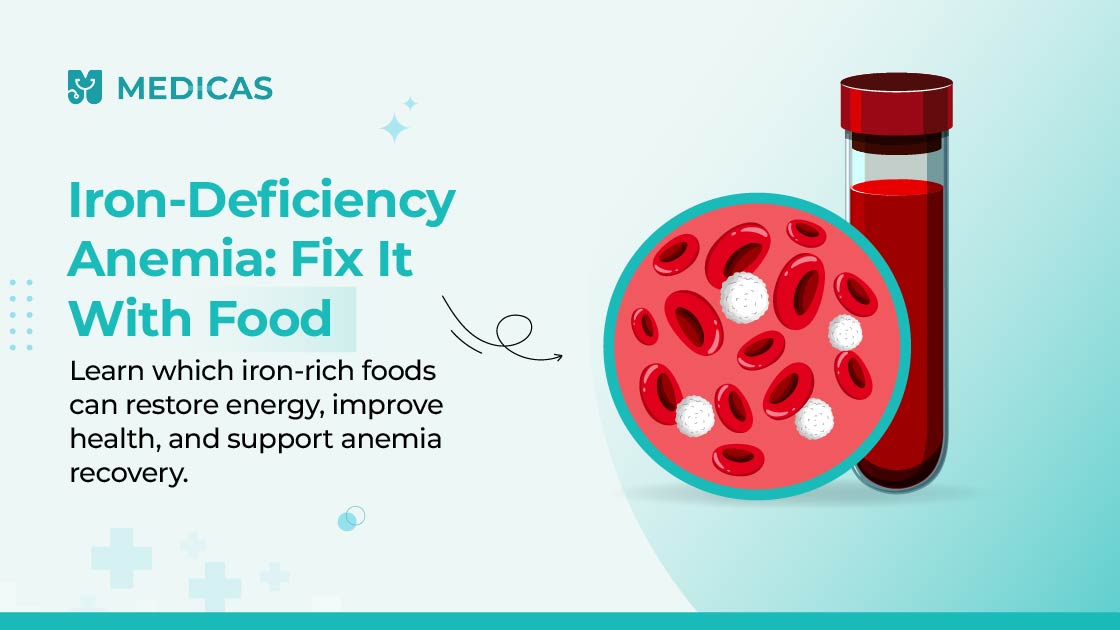Iron-deficiency anemia affects millions worldwide, draining energy and impacting quality of life. A well-planned iron deficiency anemia diet can be transformative, addressing symptoms of iron deficiency and supporting recovery. This guide explores iron deficiency treatment food, iron rich foods for anemia, and practical strategies like the best diet for iron deficiency anemia. Whether you’re curious about how to increase iron levels through diet or seeking a meal plan for iron deficiency, I’m here to provide clear, actionable insights. Let’s dive into managing iron deficiency causes with tools like booking a lab test and online doctor consultations.
What Is Iron-Deficiency Anemia?
Iron-deficiency anemia occurs when your body lacks enough iron to produce adequate hemoglobin, the protein that carries oxygen in red blood cells. This leads to fatigue and other symptoms of iron deficiency. Understanding iron deficiency causes is key to crafting an effective iron deficiency anemia diet.
Causes of Iron Deficiency Anemia
Iron deficiency causes include inadequate dietary iron, poor absorption due to gut issues, or blood loss from menstruation or ulcers. Low consumption of foods high in iron and frequent pregnancies can exacerbate the problem, making iron deficiency treatment food essential.
Symptoms to Look Out For
Symptoms of iron deficiency include fatigue, pale skin, dizziness, shortness of breath, and brittle nails. These can be mistaken for stress, but a proper iron deficiency anemia diet can alleviate them. Persistent symptoms warrant a visit to a doctor.
Who Is at Risk?
Women, children, pregnant individuals, and vegetarians face higher risks due to increased iron needs or limited intake of iron rich foods for anemia. Populations with poor access to iron deficiency treatment food are particularly vulnerable.
Diagnosing Iron Deficiency Anemia
Diagnosing iron deficiency anemia involves blood tests to confirm low iron levels, guiding the right iron deficiency anemia diet and treatment. Early detection prevents complications like heart strain.
Common Blood Tests Used
A complete blood count (CBC) measures hemoglobin, while serum ferritin and transferrin tests assess iron stores. These are available through lab testing services, ensuring accurate diagnosis for tailoring iron deficiency treatment food.
When to See a Doctor
If symptoms of iron deficiency like exhaustion or paleness persist, it’s time to consult a doctor. Knowing when to seek help can accelerate recovery through a best diet for iron deficiency anemia or medical intervention.
Online Consultations for Anemia
Online doctor consultations offer a convenient way to discuss symptoms of iron deficiency, review test results, and develop a meal plan for iron deficiency. This is especially helpful in remote areas.
Role of Diet in Managing Iron Deficiency
Diet is a cornerstone of iron deficiency treatment food, with foods high in iron playing a pivotal role. A well-planned iron deficiency anemia diet can boost daily iron intake for anemia recovery.
Iron-Rich Foods You Should Eat
Iron rich foods for anemia include red meat, poultry, fish, lentils, spinach, and fortified cereals. Jaggery and chickpeas are accessible options for iron deficiency anemia foods to eat and avoid.
Vegetarian Sources of Iron
A vegetarian diet for iron deficiency anemia relies on plant-based foods high in iron like beans, tofu, pumpkin seeds, and green leafy vegetables. These are vital where vegetarianism is common.
Foods That Inhibit Iron Absorption
Avoid tea, coffee, and calcium-rich foods during iron-rich meals, as they hinder absorption. Understanding iron deficiency anemia foods to eat and avoid enhances the effectiveness of your iron deficiency anemia diet.
Sample Meal Plan for Boosting Iron
A meal plan for iron deficiency might include:
- Breakfast: Fortified cereal with orange juice (vitamin C boosts absorption).
- Lunch: Lentil curry with spinach and whole-grain roti.
- Snack: Pumpkin seeds and a guava.
- Dinner: Tofu stir-fry with bell peppers. This supports how to increase iron levels through diet.
Iron Supplementation Through Diet
While iron supplements in food like fortified cereals help, whole foods are ideal for daily iron intake for anemia recovery. Combining iron rich foods for anemia with supplements, if needed, optimizes results.
Cooking Tips to Maximize Iron Absorption
How you prepare iron deficiency treatment food impacts absorption. These tips enhance your iron deficiency anemia diet for better outcomes.
Best Cooking Methods for Iron-Rich Meals
Use cast-iron cookware to boost iron content in dishes like spinach sabzi. Quick cooking methods, like steaming greens, preserve nutrients in foods high in iron.
Pairing Iron with Vitamin C
Pair iron rich foods for anemia with vitamin C sources like tomatoes, citrus, or bell peppers to enhance absorption. For example, add lemon to lentil soup in your meal plan for iron deficiency.
Avoiding Calcium with Iron-Rich Meals
Avoid dairy or calcium supplements with iron deficiency treatment food, as calcium inhibits iron uptake. Space these apart to maximize daily iron intake for anemia recovery.
Special Considerations for Women and Children
Women and children have unique iron needs, making a tailored iron deficiency anemia diet critical, especially in high-risk populations.
Iron Needs During Pregnancy
Pregnant women require 27 mg of iron daily to prevent iron deficiency causes like preterm delivery. A best diet for iron deficiency anemia includes iron rich foods for anemia like eggs and spinach.
Iron Requirements for Growing Kids
Children need 7-11 mg of iron daily for growth. A vegetarian diet for iron deficiency anemia with fortified foods and nuts supports daily iron intake for anemia recovery in kids.
When Diet Alone Isn’t Enough
Sometimes, a iron deficiency anemia diet needs support from supplements or medical care to address severe symptoms of iron deficiency.
Role of Supplements and Medical Guidance
Iron supplements, prescribed by a doctor, complement iron supplements in food. Regular monitoring ensures safe iron deficiency treatment food integration, avoiding side effects like constipation.
Booking an Online Doctor’s Appointment for Anemia
Book an appointment to discuss how to increase iron levels through diet or supplement needs. Online consultations connect you with specialists for iron deficiency anemia care.
Iron Deficiency Anemia Myths vs. Facts
Misconceptions about iron deficiency anemia diet can hinder recovery. Here’s a table debunking myths to clarify the role of iron rich foods for anemia.
| Myth | Fact |
| Eating spinach alone fixes iron deficiency anemia. | A best diet for iron deficiency anemia requires varied foods high in iron and vitamin C, not just spinach. |
| Only women need an iron deficiency anemia diet. | Men and children can also have iron deficiency anemia, needing iron deficiency treatment food. |
| All iron-rich foods absorb equally. | Iron deficiency anemia foods to eat and avoid matter—pairing with vitamin C and avoiding tea enhances absorption. |
| Supplements are always needed. | A meal plan for iron deficiency can suffice for mild cases, supporting daily iron intake for anemia recovery. |
| Vegetarians can’t manage iron deficiency anemia. | A vegetarian diet for iron deficiency anemia with foods high in iron like lentils is effective. |
| Iron deficiency anemia has obvious symptoms. | Symptoms of iron deficiency can be subtle, requiring tests for iron deficiency anemia diagnosis. |
| Diet changes work instantly. | How to increase iron levels through diet takes weeks, with daily iron intake for anemia recovery needing consistency. |
These facts empower you to build an effective iron deficiency anemia diet.
Conclusion
Iron-deficiency anemia can feel daunting, but a targeted iron deficiency anemia diet offers a path to renewed energy. By embracing iron rich foods for anemia, understanding iron deficiency causes, and following a meal plan for iron deficiency, you can overcome symptoms of iron deficiency. Whether you’re exploring a vegetarian diet for iron deficiency anemia or seeking how to increase iron levels through diet, resources like online doctor consultations and lab tests make recovery accessible. Your journey to health starts with small, intentional steps—let’s take them together.
Frequently Asked Questions
- What are the best foods to eat for iron-deficiency anemia? Iron rich foods for anemia like lentils, spinach, red meat, and fortified cereals are ideal for a best diet for iron deficiency anemia, paired with vitamin C sources.
- How long does it take to improve iron levels through diet? How to increase iron levels through diet typically takes 2-3 months with consistent daily iron intake for anemia recovery, depending on severity.
- Can I book an online doctor consultation for anemia? Yes, online doctor consultations provide expert guidance on iron deficiency anemia diet and symptoms of iron deficiency.
- Which specialist should I consult online for iron deficiency anemia? A general physician or hematologist is ideal for iron deficiency anemia care, accessible via this link.
Disclaimer
Medical Advice: The information provided in this blog post is for educational purposes only and should not be considered as a substitute for professional medical advice, diagnosis, or treatment. Always consult with a qualified healthcare professional for personalized guidance regarding your specific medical condition.
Accuracy of Information: While we strive to provide accurate and up-to-date information, the field of medicine and viral fevers is constantly evolving. The content in this blog post may not reflect the most current research or medical guidelines. Therefore, it is advisable to cross-check any information provided with reliable sources or consult a healthcare professional.
Individual Variations: The symptoms, causes, treatment options, and preventive measures discussed in this blog post are general in nature and may not apply to everyone. It is important to remember that each individual’s situation is unique, and personalized medical advice should be sought when making healthcare decisions.
External Links: This blog post may contain links to external websites or resources for additional information. However, we do not endorse or have control over the content of these third-party websites. Accessing these links is done at your own risk, and we are not responsible for any consequences or damages that may arise from visiting these external sources.
Results May Vary: The effectiveness of treatment options or preventive measures mentioned in this blog post may vary from person to person. What works for one individual may not work the same way for another. It is essential to consult with a healthcare professional for personalized advice tailored to your specific needs.



